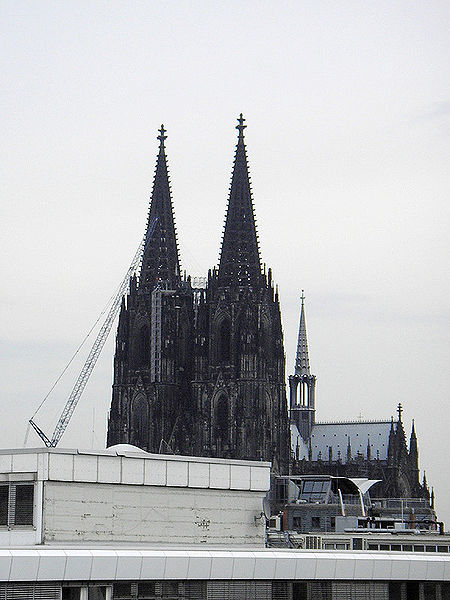My feelings from the Anga cable congress can be summed up by my reaction to Cologne’s main landmark.
A surrealist sight hits the visitor exiting the main Cologne train station. The gargantuan cathedral called the ‘Dome’ seems to rear up from the past; which is how I perceive the cable industry that Anga represents. The Dome is surrounded by modern, more ugly buildings, that seem to be slowly encroaching upon it’s lebensraum just like the Internet or DTT threaten Cable. The train station itself, with its underground lines, represents different hybrid ways of transporting things; I wonder if it’s undermining or on the contrary underpinning the great old cathedral’s foundations. From the outside it’s as if the majestic building, symbol of the cable industry, were dying. It’s blackened at places and has almost permanent scaffolding that seems to hold it up.
A different story emerges when you are inside. One’s jaw drops with the shear size. Wikipedia just told me that it was once the tallest building in the world. The vertical proportions of the arches stretch upwards as if some divine hand had pulled malleable stone upwards. Then you look closer and realise that no, this is the work of hundreds of humble stonecutters over centuries. All the carefully crafted slabs stack up in powerful columns, just like the innumerable insignificant single-valley cable plants, in nearby Switzerland, add up to a powerful force. The strength of this force will keep enemies at bay for the foreseeable future.
OK I'll leave the poetry there; now for some reporting:
A first surprise on my first visit to Anga is that it's marketed as a cable event when IPTV, FTTx, Satellite, hybrid and more abound. OK so there are a bunch of booths with nothing more than little bits of cable on display, but no-one ever stops on those anyway and one sees one or two even at IPTV World forum. The organisers must be doing something right though because at least one company I met, Zappware, were on the waiting list and didn’t get a booth.
Wondering around for two days wasn’t enough for my sense of direction to kick in so I kept on getting lost in the huge hall's two sections. There were an order of magnitude less booths than say at IBC, but almost all of them were mid sized. I used the Korea “Green IT” pavilion at one end as a landmark. It was a mistake because each time I passed it I felt a little worse about how clueless-marketers are trying to jump on the green bandwagon and have all but broken it before it has even left the station. The only green thing in that pavilion was the word.
On the positive side, the TivO demo on the Conax booth rocked. It was by far the most convincing illustration an industry oxymoron: walled garden OTT, where operators give access to all the content that is readily available out there, while reassuringly (?) never letting the subscriber out of their sight. The business models and content deals are not yet clear as earlier failures from the likes of Joost show, but the end-user proposition is now overwhelmingly compelling. It’s beautiful. I want it now in my home now!
The OpenTV 3D demo was the first, modest but effective, effort of using 3D in the interface itself, not just the video, which I’ve seen. 3D will not be revolutionizing mainstream interfaces soon, but I definitely got the feeling of peeking into the future.
I saw three interesting companies from my hobbyhorse Quality of Experience area. Ineoquest where present with a big booth clearly hoping to push their IP and head end leadership further into the cable market. Skyline’s Dataminer product was on prominent display. It’s an interesting way to commoditize the likes of Ineoquest by putting the effort on a central piece of software, which other quality systems then report to. Another outsider in the Quality area was the German supplier Axiros. From a background of managing zillions of legacy boxes, their approach is now built on the TR69 protocol. Axiros offer a new product that sits between the device management systems (ACS) and the devices themselves (STBs) so that more meaningful info can be taken from each device. Axiros performs some of the QoE monitoring functions themselves this way.
I got a private demo from German STB maker Winbox. They had a really simple “why-didn’t-I-think-of-that” ideas and an effective demo for simple « push » playlist. A VoD server pushes short content like trailers to device’s local storage (HD or Flash memory) so a personalised preview or barker channel is available. If not a killer app, this could at least be a killer VoD-ARPU generator...


Vous devez vous connecter pour laisser un commentaire.